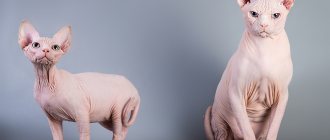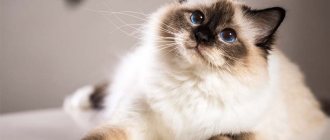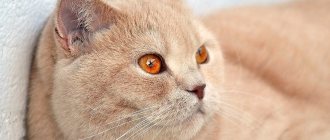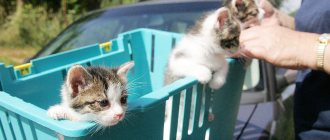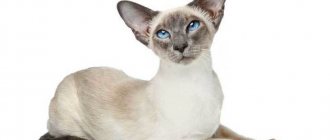- Pets
- >>
- Cat breeds
* Here is a photo of a typical representative of the Burmese cat breed . You can send us photos of your animals by email, and we will post them on the website. Don't forget to send your pet's name.
Other breed names:
Sacred Burma
Video
* We invite you to watch a video about the Burmese cat . In fact, in front of you is a playlist in which you can select and watch any of 20 videos about a given cat breed by simply clicking on the button in the upper right corner of the window. In addition, the material contains quite a lot of photos. By looking at them you can find out what a Burmese cat looks like.
In this article:
|
Colors
The following types of colors are typical for Burmese:
- Gray-blue (Blue Point);
- Brown (Seal Point);
- Cream (Cream Point);
- Red, red (Red Point);
- Chocolate (Chocolate Point);
- Lilac Point;
- Adding spots and stripes to the main color (Tabby);
- Tortoiseshell with multi-colored spots (Tortie);
- With specks and stripes (Tortie Tabby).
According to the standard, pigmentation is allowed on the tail, paws, ears and muzzle. All paws have white “socks” (without spots); the front paws also have “spurs” (between the largest pad and the joints).
In the photo there is a Sacred Burmese cat, popular colors: red, lilac, chocolate
Breeding this breed is difficult and expensive. It is difficult to get a pet with perfectly drawn “spurs” and “gloves” on its paws. Females give birth to 2, maximum 4 kittens. Newborns are painted white; the color change does not occur immediately, but after several days or even weeks, and over the years it darkens even more.
History of the origin of Burmese cats
The origin of this breed is surrounded by beautiful myths and legends of ancient Burma, where these cats lived in temples for many years. An ancient legend says that Burmese cats used to have snow-white fur without any dark spots or markings. One day, robbers broke into the ancient temple in which the sacred statue of the goddess was kept. They wanted to destroy the temple and steal a valuable statue of the goddess.
The abbot of the temple, who was protecting the statue of the goddess, was killed, and his pure holy soul moved into his beloved cat named Singh. The cat, according to legend, stood near the head of his dead owner, the color of his fur changed, and his eyes became blue. The cat screamed shrilly, and the other monks were able to find the strength to drive away the robbers. The enemies failed and fled, and all the cats that lived at this temple received sky-blue eyes, the same as those of the statue of the goddess, and a beautiful golden color.
Interesting fact: In the first decade of the 20th century, cats of this breed were imported to France, where selection work to breed the breed began. However, this breed was almost completely exterminated during the harsh times of the world wars. There were very few cats; some animals died in houses from bombing and shelling, others from hunger.
To prevent the breed from disappearing altogether, Burmese cats began to be crossed with Persian and Siamese breeds. In 1925, this breed was given an official name, and the first exhibition of Burmese cats took place in Italy back in 1926. In 1966, the breed found recognition in Britain, and later in the USA. Today, this cat breed is considered very popular all over the world. These cats with beautiful long hair, sapphire-colored eyes and point coloring are bred all over the world.
Burma - a cat from legend
Of the many breeds of domestic cats, only one has the word “sacred” in its name, and this in itself speaks volumes. Although the Sacred Burmese still remains among the rare breeds, interest in it among true connoisseurs of cat virtues is growing all over the world. This is not surprising, because the Burmese cat is one continuous advantage.
The sacred cat Burma is a faithful companion of Buddhist monks
Many Buddhists in different countries of the world prefer to keep these cats and even meditate with them - isn’t this in itself surprising?
History of the breed
It is unlikely that there is another breed with which so many legends and simply beautiful mysterious stories are associated. Be that as it may, the Burmese cat enjoys special patronage and veneration among modern Buddhists - just like a century ago, when fluffy, mysterious beauties lived in many monasteries of Burma as almost divine oracles, and inseparably accompanied monks and pilgrims everywhere.
How and when did these cats end up in Buddhist monasteries? There is no direct and specific information about this; the origins of the breed are lost in the intricacies of Eastern myths.
Once upon a time, a legend tells, in Burma there was a magnificent temple of Lao Tsun, erected in honor of the foremother of all things on Earth. When the abbot of Man-Ha offered evening prayer at the golden statue of the deity with sapphire eyes, he was attacked by enemies and killed. The white temple cat Singh clung to her owner's body in despair, and at that moment a miracle happened. A glow appeared around the statue, and the cat began to transform. Her fur acquired a golden tint, her paws darkened; but where they touched the monk’s chest, snow-white “gloves” remained, and Singh’s eyes became sapphire. The next morning, all the other cats living in the temple also acquired this appearance.
Modern genetic research is not so romantic, but it confirms that this breed originates from Burma. According to the most common version, Siamese and Persian cats that lived here for thousands of years naturally interbred. Some of the offspring developed, and subsequently became established, wonderful blue eyes and white “socks” on their paws, and other breed qualities gradually developed.
Burma eyes are a divine gift
A precious treasure of Burma, a pair of sacred cats was presented to the Europeans in gratitude for saving the same Lao Tsung Temple, but at the very beginning of the last century. So, at least, the continuation of the legend says. The cat could not survive the long journey on the ship to the shores of France, and the pregnant cat reached a new place of residence and gave birth to kittens there. It was from them that the entire European population of sacred Burma supposedly originated.
A hundred years ago, the breed gained popularity in Europe. In France, Sacred Burma received its first official recognition, which dates back to 1925. Since then, the Burma has been keeping its official chronicle - for every truly purebred cat, the pedigree can be traced back to twenty generations, and its starting point is exactly at the beginning of the last century. It is interesting that the standard of this breed is unusually stable - it also remained practically unchanged for almost a whole century, which is a rarity for various felinological organizations.
Video: The world's only sacred breed
Burmese cat - description of the breed
Burmese cats are medium-sized cats with a strong body with strong and well-developed muscles. The height at the withers is about 30 cm, the weight of cats is about 4 kg, males are 5-6 kg. The body is neatly built, the shoulders and hips are approximately the same size, the bones are large and strong. Sexual dimorphism favors males, which means that cats are much larger than cats, and cats have brighter fur colors.
The limbs are small, but strong and muscular, the paws are round. The paw pads are mostly pink, although they can also be colored like the points. Burmese cats have very beautiful, long and fluffy tails, and it is for their beautiful tail and fluffy fur that breeders value them so much.
The head of cats of this breed is large and round. The ears are small and erect. The tips of the ears are slightly rounded. Small hair tassels on the ears are allowed. The eyes are large, round, sapphire blue. The mustache is long. The muzzle, tips of the paw ears and tail are painted in darker colors.
Interesting fact: Burmese cats have beautiful, soft, long hair. Their wool is silky, does not tangle, and has no undercoat. On the cat's back and chest the hairs are even, but in the belly area the hair may be slightly curly. On the chest there is a beautiful collar of long and silky wool.
The gait of Burmese cats is soft and smooth. Cats have innate royal manners; they are neat, calm and majestic. The average life expectancy of Burmese cats is 12-15 years.
Burmese kittens are born almost white, but over time, markings of darker tones appear on the face, paws and tail. In adult cats, the nose and muzzle, ears, tail and paws are painted in dark colors.
Breeding work
Enthusiasts of the breed, who are becoming more and more numerous in Russia, are trying not only to widely popularize the still quite rare Burmese cat, but also to preserve and improve its breed qualities as much as possible, expanding and qualitatively differentiating the gene pool of the sacred Burmese. Breeding work in this case must be well thought out, and responsibility for its results falls on the few nurseries that are still very numerous and value their reputation very much.
Preparing the Parent Couple
Along with the popularity of the Burmese cat, the number of producers whose combination of blood can be used in breeding work is also growing. The selection of the parent pair is extremely important for successful reproduction in this breed. Therefore, it is advisable to entrust this delicate topic to professionals, and not just breed your favorite cat “for health” with a cat who lives nearby.
A good parent couple means beautiful and healthy children
To organize a successful mating, you need to have a good knowledge of at least the genetics of colors, and even better - how prepotent the future parents are, what qualities they usually pass on to their offspring and how they can be improved.
The parent couple should begin to prepare for mating no later than a month before the “X-hour”. Both animals must be promptly vaccinated and freed from parasites. Don’t be shy to ask for a certificate about whether your animal’s intended partner is healthy—during mating, the risks of transmitting infection are high. In addition, there are many diseases that can become dangerous to the health and even the life of future babies.
Pregnancy and kittens
During the period of waiting for babies, the mystery of the Burmese cat fantastically increases many times over - probably as many times as the number of little lives the expectant mother is maturing in. At this time, she needs increased attention and care, tries to spend more time with her owner, receive confirmation of love from him - for Burmese, like any woman, such signs are important and necessary.
It is no coincidence that the Sacred Burma is called a female breed - out of the entire number of household members, this cat usually chooses the mistress as the main object of worship and service. And not during the pregnancy of the woman she loves, Burma will definitely take special protection over her. But this amazing cat expects a similar attitude towards itself.
This is how Burmese kittens are born
Burmese kittens, beautiful white balls of fluff, are born approximately nine weeks after the act of parental love. As befits all cat cubs, they are blind and deaf, and they are only interested in their mother - her warmth and her delicious milk. But somewhere around the third day of life, a completely helpless baby literally before our eyes begins to manifest his bright individuality - the kitten’s white fur gradually acquires its own unique colors and shades. Watching this mysterious process is extremely interesting.
The nose is painted first, the outlines of the mask appear on the muzzle, then the paws, ears, tail darken... By the age of two weeks, an experienced breeder of a kitten will already be able to guess what kind of adult animal this cute baby will turn out to be. Of course, genetically, you can try to assume this in advance, but nature in general is a big fan of presenting surprises to people, and the mysterious nature of the sacred cat is even more so.
Castration and sterilization
Sufficient indications for sterilization of a Burmese cat can be not only health problems, but also the conditions under which the breeder sells a pet-class kitten that does not have access to breeding for various reasons. In other cases, responsible veterinarians usually discourage owners of this breed from spaying or neutering their animals.
This cat loves you - love her back
The Burma is absolutely non-aggressive and is distinguished by adequate behavior even during periods of hormonal peaks. Sterilization is by no means a simple and harmless operation; moreover, it is performed under general anesthesia, which can negatively affect health. Before you decide to undergo surgery, weigh the pros and cons of the operation - it is likely that you can do without it.
Popular colors of Burmese cats
Burmese cats have a beautiful point color.
There are quite a lot of different colors, but here are the most popular ones:
- SBI n - chestnut or chocolate point. This color is considered the brightest and most contrasting. The points are bright brown, evenly and completely colored. An even diamond-shaped mask should stand out on the cat’s face. There should be no light areas on the points; white spots on the points are not allowed at all. At the age of 2.5-3 years, the fur on the back and sides darkens slightly; in rare cases, the animal’s abdomen darkens;
- SBI-21 this color is characterized by dark brown striped points. The color is very similar to the previous one, but the points have dark stripes;
- SBI a - blue or silver point. The general color of the animal is white, and the points are cold silvery tones. The points must have an even color. On the face there is a diamond-shaped mask of gray color, the ears are gray. On points, light colors are undesirable, but acceptable. By the age of 2.5-3 years, the back and sides of the animal are covered with a so-called silvery cloak. In rare cases, the pet’s belly may also darken;
- SBI a 21 - striped silver point. The color is the same as the previous one, but the points are striped;
- SBI b - classic chocolate point. This color is not as bright and contrasting as the previous ones. The tail and dark points should be well and evenly colored. It happens that the points are very light; they can be the color of milk chocolate. The mask on the muzzle is not wide. The diamond shape of the mask ends behind the outer corners of the eyes, and the forehead is covered by the mask approximately to the middle. Light areas on points are undesirable; the body body does not darken with age;
- SBI b 21 - the same chocolate point only with stripes. The classic color is white combined with light red striped points. Some have a red color on the nose, palate and paw pads. Over the years, the animal's body does not darken;
- SBI c - lilac point. Pearl-colored points. The mask on the face, like that of the blue point, is not wide, the points are evenly colored in pearlescent color. The sides of this color never darken;
- SBI c 21 - lilac point with stripes.
Standards
The appearance of the Burmese is immediately remembered - its look is so expressive and its color is amazing. Individuals are of average size, males weigh no more than 6 kg, females - no more than 3. In color they resemble Siamese cats, but have a more docile character and graceful physique.
| Standard | Description |
| Head | Round, wide, with expressive features. The forehead is convex, but moderately; the skull is longer than wide. The muzzle is developed, rounded and wide. The cheeks are plump and rounded. Cheekbones stick out. The chin is powerful and strong. The nose is “Roman”, not long, the transition may or may not be present. The ears are slightly tilted forward, located on the sides of the skull, and are small. Their tips are rounded. The inside of the auricle is moderately pubescent. The neck can be either short or long, but is always muscular. |
| Eyes | Expressive, large, round. Set wide apart. The iris can be colored in different shades of blue, from light to dark. The latter, by the way, are valued higher. |
| Torso | Elongated, squat, with developed muscles. The bones are strong. |
| Paws | Muscular, medium length, rounded, large paws. Tufts of fur are visible between the toes. The pads can be brown, brown or pink. |
| Tail | Medium length, dark, with a fluffy tip. A funny feature: the Burmese cat wears it raised when walking. |
The defects of the breed are the presence of colored inclusions on the white areas (this results in disqualification); squint, silvery shine in the eyes (or one), bends in the tail, different eye color.
Character and habits of Burmese cats
Sacred Burma is a true personification of wisdom and tranquility. These animals hate noise and fuss. Instead of active games, Burmese cats like to sit and calmly watch what is happening around them. They are very calm, it is very difficult to anger a Burmese cat, and even if this can be done, it will not hiss or rush at the offender, but will simply get up and calmly leave with royal majesty, not wanting to get involved in a conflict.
Interesting fact: Burmese cats are not only pets, but also true friends. They are extremely loyal to their owner, very sociable, but at the same time they do not tolerate bad treatment. Cats of this breed are distinguished by high intelligence and innate good manners. They are always majestic and calm, they understand well what a person says, and quickly get used to the tray, scratching post and sleeping place.
Animals can treat children differently depending on the character of a particular individual and mood. These cats are not very playful, but can be quite tolerant of children. Relations with other animals are calm. Burmese get along quite well with dogs, provided that the dog does not offend the cat. Rodents and birds can become prey for a cat, so animals should not be kept in the same room.
The main problems usually arise with unsterilized cats and female cats. At a time when the cat’s nature demands its way, the animal can become aggressive, meow and especially fiercely guard its territory. Males mark their territory. Castrated and sterilized cats always behave calmly and decently. For older people, Burmese will be excellent companions who will not let you get bored.
Interesting facts about Burmese cats
Sacred Birman kittens are born with soft, snow-white fur, which gradually darkens with age. The coloring of the Burmese cat is a type of albinism. Wool is dyed dark in so-called “cold places” where blood circulation is poorer. You should also remember that if a cat is exposed to the cold for a long time, its fur may darken prematurely.
A unique fertility record was set by the Burmese cat. A mother named Antigion gave birth to 19 kittens in one litter. The Birsk breed includes a cat that has set a record for longevity. On average, cats live from 12 to 15 years, but the Catalina cat from Australia was able to live as much as 35 years. This cat is listed in the Guinness Book of Records as the oldest cat in the world.
Burmese kittens are born with disproportionately large ears, but over time the kitten's head and body grow into correct proportions. Shorthaired Birmas are very rare, but they do exist. The main characteristics of the shorthaired Burmese are white socks on the paws, short hair and a small undercoat. The cat's head is large and round, its eyes are sky blue.
Seals of this breed are excellent hunters; they will happily stretch their bones while hunting in the garden. Seals like to hunt more because of sporting interest; domestic cats are unlikely to eat their prey, but they can bring their trophy to the owner in order to be praised.
Cats of this breed are not adapted to living in cold climates outside homes. These cats are very heat-loving, they quickly catch a cold outside in bad weather, and in houses these animals find the warmest place to rest. By the way, only Burmese people like to sleep under a blanket at night.
Breed defects
The sacred Burmese cat is perfection in every way. But there are intrabreed problems that you should know about in advance and be prepared for if you are seriously thinking about bringing this beautiful animal into your home.
Tendency to diseases
Excellent health is one of the undoubted breed advantages of the Burmese cat. She has a strong immune system and high resistance to various types of infections. With proper care, Burmese cats rarely get sick, and their average life expectancy reaches sixteen years - this is an excellent indicator.
The limited gene pool of the Burmese cat entails hereditary diseases
But the limited gene pool has created certain problems with heredity - there are a number of diseases to which representatives of this breed are often susceptible. Try to eliminate the possibility of bad heredity even at the stage of purchasing a kitten. But if the illness makes itself felt, do not self-medicate - contact only qualified specialists in a timely manner. The most common problems in the list of breed pathologies are:
- congenital hypertrophy;
- corneal dermoid;
- spongiform degeneration;
- body trembling;
- excessive concentration of creatinine in the blood.
Responsible breeders will never allow animals with poor heredity to be bred . Therefore, the risks of acquiring a sick baby are constantly decreasing, but they exist and should be remembered.
Breed marriage
Breeding a Burmese cat is in many ways a breed lottery, a task with many unknowns. That's what makes it interesting, actually. The bright white edging of the paws, which is considered one of the main breed characteristics, is passed on from parents to offspring with a high degree of unpredictability. If the baby's aristocratic markings are of insufficient size or irregular in shape, he will definitely not win at the exhibition.
It is very important to have the correct white gloves
But such a breed marriage in no way interferes with the cat’s life and does not reduce its other great advantages. And a pet-class baby costs an order of magnitude cheaper. Therefore, if you are not striving for a show career for your pet, pay attention to the kitten wearing the “wrong” gloves - you will never regret it.
Pros and cons of Burmese cats
Advantages of the Burmese breed:
- Burmese cats are very beautiful. The aristocratic appearance speaks of the elitism of the breed. This breed includes the beauty of the Persian, Siamese and Burmese breeds. The cats have beautiful fluffy point-colored fur, blue eyes and a huge fluffy tail;
- Burmese are able to understand the feelings of the owner and adapt to the mood. If the owner is sad, the cat will always come to the rescue and try to support the owner by gently purring and trying to attract attention;
- Calm and flexible character. It is very difficult to anger a cat of this breed, and even if this happens, the cat will not take revenge or hiss, most likely, he will simply leave without wanting to enter into a conflict;
- Burmese have excellent health; no genetic diseases have been identified in cats of this breed, and with good care, the cat can live a long and happy life;
- Cats of this breed do not require complex care despite their rather long hair. The animal's fur has an even, smooth structure and does not tangle or mat;
Disadvantages of the breed:
- Cats of this breed should not be allowed outside during the cold season as the animals are not adapted to cold climate conditions. Burms get cold quickly, and their coat can darken prematurely in the cold;
- Burms do not like intrusive affection; if the cat is in a bad mood, it may avoid people;
- Pets of this breed are not suitable for families with babies and small children. These animals do not like to be cuddled or carried. They don’t like noise and fuss, and although Burma won’t hurt a child, they won’t play for hours and tolerate bad treatment;
- Unneutered cats mark their territory, and unsterilized cats can become aggressive and meow at night;
- Price. Kittens of the Burmese breed cost from 40 to 100 thousand rubles, depending on the pedigree and nursery, which is not cheap at all.
Burmese or Burmese?
People often confuse Burmese cats with Burmese cats, considering them to be varieties of the same breed. However, this is a misconception.
IMPORTANT: Burmese and Burmese are two different breeds, differing both in external characteristics and in temperament.
These cats have one common ancestor - the Siamese:
- Burma - a mixture of Siamese and Persian breeds
- Burmese - a mixture of Siamese and red shorthair
Burmese cat
External features of the Burmese cat:
- short, smooth coat that lies tightly to the body and shimmers like satin
- solid color, may be slightly darkened on the face
- The main shades of wool are chocolate, lilac, sable, and blue. In cold weather the color becomes darker
- medium-sized graceful, but at the same time muscular body
- hind legs longer than front legs
- wedge-shaped head
- the tail is thin, tapering towards the end
- the eyes are round, giving the muzzle a naive, childish expression, and are honey-colored
- Despite their small size, the animals are quite weighty, which is why they are often called “bricks in silk”
The temperament of Burmese cats is also different from Burmese:
- very energetic and lively
- extremely playful
- strive for leadership
- resemble dogs in character
- do not like loneliness, always try to attract attention to themselves
- quite "talkative"
Burmese cat
However, just like the Burmese, the Burmese cat has an easy-going character:
- affectionate
- highly intelligent
- devoted
- devoid of aggressiveness
Breeding Burmese cats
Breeding the Burmese cat breed is not an easy and extremely important task, because the health and vitality of the offspring depends on the correctly selected parents and their health.
Therefore, when breeding cats of this breed, you must adhere to the following rules:
- Males and female cats with any congenital abnormalities cannot be used for breeding;
- Cats of any breed used for breeding must have a mustache;
- Breeding cats must have a certificate that confirms the male health of the stud cat;
- A breeding cat can be used for mating if she has had no more than 3 births in the last 2 years;
- A cat that cannot give birth naturally or has previously had a caesarean section cannot be used for breeding;
- There should be a break of 3 weeks between matings with different cats;
- All animals used for breeding must be microchipped;
- Cats with an umbilical hernia, deafness and other diseases are not allowed for mating;
- Mating is carried out on the territory of the male. For mating, a separate room should be allocated where the animals can quietly retire. Before mating, animals must undergo a medical examination;
- During mating, the owners must provide the female with the usual food and tray so that the animal feels good;
- Childbirth must be supervised;
- To register kittens, the owner must provide the kittens themselves, a mating certificate filled out on the club's letterhead with the signatures of the owners of both parties. The direction given by the instructor for this mating. The animal's name is included in documents in any language at the request of the owner;
- Animals without a pedigree cannot participate in mating; they must be sterilized;
- Kittens under 12 weeks cannot be separated from their mother. Animals can be transferred to another home after the kittens are weaned from the mother's breast and receive all necessary vaccinations.
Catering
Sacred Burmese cats are real gourmets. They prefer quality to quantity: they don’t eat much, but they choose the tastiest morsels.
Adults (over six months old) need to be fed no more than 2 times a day: morning and evening. Exceptions are cats in poor health, pregnant and lactating, old, or suffering from any disease. Of course, it is better to make these kinds of changes in diet after consulting with your doctor.
Natural products
Breeders advise feeding the Burmese with natural food, carefully monitoring the quality of the products and the balance of the diet.
You can give:
- Poultry (chicken, turkey), veal, beef, rabbit and lamb. It is pre-frozen, and when taken out of the freezer, it is scalded with boiling water and cut into convenient pieces (or passed through a meat grinder).
- Porridge: oatmeal, buckwheat, millet, rice, pearl barley. Babies up to 3 months can be given liquid semolina porridge cooked in milk, while adults - in water.
- Sea fish: trout, hake, salmon. From time to time you can give boiled shrimp and squid. Fish is given no more than once a week, otherwise the cat will develop urolithiasis.
- Vegetables (pumpkin, zucchini, carrots, cucumber, green beans), greens (parsley, dill, green salad), fruits (apples, pears, melon, dried apricots, strawberries, bananas). They are served both fresh and stewed.
- Fermented milk products (cottage cheese, sour cream, fermented baked milk, Varenets, kefir, natural yogurt, yogurt). Non-greasy, without dyes or harmful additives.
- Eggs: chicken eggs are boiled and only the yolk is given, quail eggs - whole.
- Olive or vegetable oil (a few drops in the porridge daily).
Additionally, your doctor may prescribe vitamin complexes and brewer's yeast (in tablets).
Forbidden:
- Fatty meat (pork, goose, duck);
- River fish, bony fish;
- Offal, lard, bones;
- Potatoes, eggplants, citrus fruits, onions, garlic, white cabbage, legumes;
- Flour, baked goods, sweet, smoked, salty;
- Whole cow's milk;
- Yoghurts with additives;
- Chocolate;
- Grapes, avocado;
- Human canned food, vitamins for people, food for dogs and other animals.
Recommended food
Below are the recommended holistic foods. Links with the names of the food are clickable, on them you can, within our website, get acquainted with the descriptions of the food and read reviews from owners of cats of the Sacred Burmese breed.
| Holistic | Holistic | Holistic |
| Wildcat | Carnilove | Applaws |
Make sure that clean water at a comfortable temperature is always freely available, not from the refrigerator, but not scalding hot. Not from the tap! Only cleaned with a filter or settled.
Pictured are kittens of the Sacred Burmese cat
Caring for Burmese cats
Cats of the Sacred Burmese breed are unpretentious and do not need any special tricks. Caring for them is quite simple and anyone can handle this task. Before bringing the cat into the apartment, the room must be prepared. You need to go through your home and remove all protruding wires and cables. Put away expensive porcelain, gadgets and other items that your cat might accidentally break.
Also, the room needs to be made safe, all cracks where the cat could get stuck should be closed. Tightly cover toxic substances that could poison the animal. In addition, the animal needs to have its own personal space. The cat needs to buy a soft and comfortable bed, a tray and a place for food, equipped with large bowls. The cat will also need a scratching post and toys. For trips to the veterinarian, it is worth purchasing a carrier.
In general, caring for a cat is not difficult. You need to bathe your cat once every 3-4 months with a special shampoo. The eyes and ears of the animal are examined and carefully wiped with a cotton pad. Nails are trimmed with special scissors every three weeks. Despite the long hair, it does not cause much trouble. Once a week, the animal must be combed with a special soft comb to remove dead hair.
Fun fact: Raising Burmese cats is usually easy. Cats feel their owner well and quickly understand what is required of them. The main thing is not to miss the moment and explain to the cat the rules of behavior in your home from childhood. Animals should not be allowed to scratch furniture or climb onto tables. A cat's litter box training is usually done by a breeder.
Burms don't tolerate shouting and they especially don't like being shouted at, so try not to do this. When committing negative actions, switch the animal’s attention to toys. Sacred Burmas do not tolerate cold; there should be no drafts in the room where the animal is kept.
Maintenance and care
Burmese cats need the attention of their owner. They are definitely not suitable for people who spend little time at home. Therefore, when purchasing a representative of this breed, be prepared for the fact that you will have to devote time to him.
The animal loves warmth, so you need to take care of the absence of drafts. Burmese cats prefer to sleep next to their owner and do not always recognize their beds. Be prepared for the fact that your pet will not be happy with a house at a height.
The cat is very clean and demanding about the cleanliness of dishes, water, quality of food and tray filler.
Your pet's beautiful coat requires care - you need to comb the animal well a couple of times a week. It is possible that mats may form during the molting period. The animal should be trimmed or bathed as needed. Read about how to bathe a cat in another article. There I tell you when it is really worth spending a bath day, and in which cases it is enough to comb the animal well.
It is important to regularly brush your teeth with special devices or take your animal to the clinic for tartar cleaning. Trim your nails about once a month - how to do this so as not to harm your pet is described in detail in a separate article.
Nutrition
Like any animal, the Burmese cat needs good nutrition. The diet should consist of proteins, fats and carbohydrates in the right proportion. I do not recommend feeding a purebred cat homemade food. Providing adequate nutrition on your own is not easy; most likely, a deficiency of essential elements will affect your pet’s health. It is best to pay attention to professional food, which the breeder will recommend.
The animal must receive enough animal protein, as well as vitamins to maintain a shiny and silky coat.
You should not include fatty and fried foods, salty and spicy foods, as well as sweet foods in your diet. Eating from the human table will lead to intestinal problems.
Diet of Burmese cats
Burmese cats are good judges of what they eat. They are able to control themselves and not overeat. You can create your pet's diet using only dry food. Dry food is completely balanced and contains all the necessary supplies of vitamins and microelements.
Sometimes you can pamper your cat with canned food. If you want to create a cat’s diet from natural products, do not forget that it must be balanced.
The daily diet should include:
- Thermally processed meat (chicken, turkey, rabbit, lean beef);
- Thermally processed fish of low-fat varieties. Under no circumstances should you give your cat smoked or salted fish;
- Liver, lung, spleen;
- Cereals (buckwheat, pearl barley, oatmeal);
- Dairy products (kefir, cottage cheese, sour cream);
- Boiled vegetables.
Chicken or quail eggs can be given in small quantities. You should not feed the animal from your table. Pet food must be prepared separately without adding salt or spices. Pregnant and weakened cats, as prescribed by a veterinarian, are given vitamin complexes that are purchased at veterinary stores.
In addition to food, cats should have clean water in a separate clean bowl. Always make sure that the dishes from which the cat eats are clean; any remaining food must be removed. It is better to leave dry food in reserve.
Price
You should only buy a Burmese cat from a trusted breeder. The peculiarity is that at an early age (up to six months) you will not find clear indicators of the breed in the animal. An unscrupulous seller may sell a kitten that turns out to be a mixed breed or even outbred.
If you plan to take part in exhibitions or engage in breeding with your cat, you should take a kitten that is already 6 months old. At this stage, it is possible to largely eliminate the shortcomings of the breed for which the animal can be disqualified.
The cost of a pet for home keeping is from $550. Kittens purchased for breeding are more expensive - from 800 to 2000 dollars. The cost of show-class animals is at least $2,000.
Diseases and health problems
Despite the long selection history of this breed, these cats are famous for their excellent health. Burmese cats do not have any serious genetic diseases. With age, like cats of any breed, Burmese can develop cardiac diseases, gastrointestinal and kidney diseases. Therefore, once every six months, the pet must be shown to a veterinarian for timely detection and treatment of existing diseases. It is always easier to cure a disease at an early stage than in an advanced stage.
Vaccinations, which must be done on time, will protect your cat from various infectious diseases. Small kittens are vaccinated for the first time at the age of 2-3 months, after which vaccinations are given annually.
Even if the animal does not go outside, vaccinations must be done. Viruses and infections can enter the home on clothes and shoes, and can also be transmitted by parasites. Fleas can enter apartments through ventilation, cracks, from basements and neighboring apartments. Therefore, it is necessary to periodically examine the animal.
Domestic cats and male cats must be spayed and neutered. This is done so that the animal does not suffer. It is better to castrate cats and cats at the age of six months; at this time, animals tolerate this procedure more easily. Neutered cats are prone to obesity, so they need to be fed special food for neutered cats.
Health
This breed has a predisposition to kidney and digestive system diseases. Therefore, it is very important to take care of animal nutrition, since it is this that often affects the occurrence of problems with these organs.
One of the common ailments is cysts, which can be prevented by regularly examining your cat at the veterinarian. Animals are very temperamental and can be too active during the rutting period. Therefore, it is worth considering castration or sterilization. Also, if the female has not mated for several years, problems may begin in the genitourinary system.

